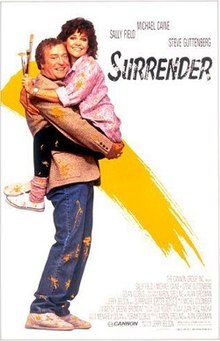Em se tratando de comédias românticas, há pessoas que dizem que, se você viu uma, viu todas. Do primeiro contato tempestuoso até o triunfo do amor ao final, o gênero é comumente previsível… mas ainda entretém. Filmes como “Ensina-me a Querer” (1987) não trazem exatamente frescor ao gênero da comédia romântica, pois não acrescentam nada de novo. Mas, mais uma vez, são bom entretenimento.
When it comes to romantic comedies, there are people who say that if you’ve seen one you’ve seen them all. From the tempestuous first encounter to the triumph of love in the end, the genre is often predictable… but still enjoyable. Films like “Surrender” (1987) aren’t exactly a breath of fresh air in the romantic comedy movie genre, as they bring nothing new to it. But, again, it’s still an enjoyable ride.
Sean (Michael Caine) viu alguns relacionamentos terminando mal, em audiências perante a um tribunal – afinal, ele é um escritor que usou como inspiração suas companheiras e por causa disso estas mulheres mereciam parte dos lucros com as vendas dos livros. Daisy (Sally Field) é uma pintora que trabalha numa espécie de linha de produção, criando pinturas que são todas iguais para clientes não muito exigentes. Ele não quer um novo relacionamento, enquanto ela está presa em um sem futuro. Eles se conhecem numa festa beneficente que acaba mal, com uma invsão de bandidos armados que mantêm os convidados reféns. Sean e Daisy são amarrados juntos pelados, no mais ridículo primeiro encontro de todos os tempos.
Sean (Michael Caine) has had a few failed relationships that ended in settlements in court – after all, he is a writer who took inspiration from his partners and therefore these women deserved a share of the profits from the novels. Daisy (Sally Field) is a painter who works in a kind of art assembly line, creating paintings that are all equal for non-demanding clients. He doesn’t want another relationship, she is currently stuck in one that has no future. They meet at a fundraiser party gone incredibly wrong, as it is invaded by armed bandits who hold the partygoers hostage. Sean and Daisy are tied together naked, in the most ridiculous meet-cute ever.
Sean se apaixona à primeira vista – isso vai acontecer logo com ele, que preferia entrar num elevador com um cão bravo a entrar num com qualquer mulher. Ele vai atrás de Daisy e eles fazem tudo rapidamente: têm um encontro, se beijam, transam, fazem planos para o futuro. Duas semanas incríveis se passam até que o velho namorado de Daisy, Marty (Steve Guttenberg) volta de uma missão. Detalhe: durante essas duas semanas, para testar Daisy e ver se ela não é egoísta, Sean diz a ela que está falido, quando na verdade é um autor best-seller.
Sean falls in love at first sight – this happening to him, who would rather ride an elevator with an angry dog than with any woman. He goes after Daisy and they do it all quickly: they go on a date, kiss, make love, make plans for their future. Two amazing weeks go by until Daisy’s old boyfriend Marty (Steve Guttenberg) comes back from a mission. Detail: during these two weeks, to test to see if Daisy is selfish, Sean tells her he’s broke, when in reality he is a best-selling author.
“Ensina-me a Querer” nos faz pensar sobre as vidas e dificuldades de pessoas criativas. Sean diz que está sofrendo de bloqueio criativo, enquanto Daisy não consegue sobreviver vendendo sua arte. Sean diz que praticamente desistiu de escrever, enquanto Daisy não consegue terminar nenhuma de suas pinturas autorais. Sabemos que é tudo mentira de Sean, mas coisas como bloqueio criativo devem ser discutidos no cinema – como já aconteceu em “Poderia Me Perdoar?” (2018) e mesmo em “O Iluminado” (1980). Outro assunto interessante neste filme é a inspiração artística: no final, Sean percebe que não foi roubado por suas mulheres, mas sim as roubou, no sentido de que ele se inspirou nas mulheres de sua vida e só foi pagá-las por essa inspiração após determinação de um juiz.
“Surrender” makes us think about the lives and difficulties of creative people. Sean says is suffering from writer’s block, while Daisy can’t survive by selling her art. Sean says he has virtually quit writing, while Daisy can’t finish a single painting of her own. We know it’s all bullshit with Sean, but things like writer’s block should be discussed in movies – as it has been in “Can You Ever Forgive Me?” (2018) and even in “The Shining” (1980). Other interesting issue found in this film is artistic inspiration: in the end, Sean realizes he wasn’t robbed by women, but he has robbed them, in the sense that he took inspiration from the women in his life and wasn’t willing to pay them until this was decided by a judge.
No pequeno papel de Ace Morgan temos o ex-ator mirim Jackie Cooper. Ele conseguiu seu primeiro papel no cinema em 1929, aos sete anos, e naquele mesmo ano passou a fazer parte da turminha dos Little Rascals de Hal Roach. Seu papel mais lembrado dessa época foi em “O Campeão”, de 1931. Aos trinta e poucos anos de idade ele começou a dirigir principalmente para a televisão, mas ainda atuava em papéis pequenos em filmes como “Ensina-me a Querer”, seu último papel como ator.
In the small role of Ace Morgan we have former child star Jackie Cooper. He got his first acting job in 1929, aged seven, and at that very same year he got a spot in Hal Roach’s Little Rascals. His best remembered juvenile role was in 1931’s “The Champ”. In his thirties he started directing especially for television, but still played small parts in movies such as “Surrender”, his last role as an actor.
“Ensina-me a Querer” foi produzido pelo lendário produtor Aaron Spelling. No IMDb podemos encontrar mais de 200 créditos para Aaron como produtor, numa carreira que durou cinquenta anos, mais 22 créditos como escritor / criador. Seus programas de TV mais populares incluem “Dinastia”, “O Barco do Amor”, “Casal 20” e, obviamente, “As Panteras”. Seus programas de TV geralmente tinham personagens femininas fortes, algo que só acontece em “Ensina-me a Querer” perto do final, quando o jogo vira para Daisy.
“Surrender” was produced by the legendary producer Aaron Spelling. IMDb has more than 200 credits for Aaron as producer in a career that lasted fifty years, plus 22 credits as writer / creator. His most popular produced TV shows are “Dynasty”, “The Love Boat”, “Hart to Hart” and, of course, “Charlie’s Angels”. His television shows often had strong female characters, something that happens in “Surrender” only near the end, when tides turn for Daisy.
O título em português – “Ensina-me a Querer” – é sem dúvida inspirado no título brasileiro para “Harold and Maude” (1971), que é “Ensina-me a Viver”. Na Espanha, o título do filme é “Uma Namorada para Dois” (“Una Novia para Dos”) e na Alemanha Ociental o título dado foi “Agora Não, Querido” (“Nicht Jetzt, Liebling”).
The title in Portuguese - “Teach Me How to Desire” - is without a doubt inspired by the Brazilian title for “Harold and Maude” (1971), that is “Teach Me How to Live”. In Spain, the film is titled “A Girlfriend for Two” (“Una Novia para Dos”) and in West Germany it got the title “Not Now, Darling” (“Nicht jetzt, Liebling”).
A comédia romântica que melhor tratou de problemas com dinheiro e casamentos morganáticos – isto é, casamentos entre duas pessoas de classes sociais diferentes – é “Irene, a Teimosa” (1936). Comparado a esta obra-prima com Carole Lombard, “Ensina-me a Querer” tem como único elementos comum a diferença monetária entre os dois protagonistas. A Variety comparou o filme a produções como “Confidências à Meia-Noite” (1959), declarando que “os problemas são de alguma forma atualizados, mas os personagens ainda pensam como Doris Day e Rock Hudson”. Um grande elogio, diga-se de passagem.
The romantic comedy that best dealt with money issues and morganatic marriages – that is, marriages between two people from different social groups – is “My Man Godfrey” (1936). Compared to this masterpiece with Carole Lombard, “Surrender” finds as only common element the money differences between the leads. Variety compared the film to the likes of “Pillow Talk” (1959), stating that “the issues are somewhat updated, but the characters still think like Doris Day and Rock Hudson”. A huge compliment, if you ask me.
This is my contribution to the (Aaron) Spellingverse blogathon, hosted by Gill at Realweegiemidget Reviews.







3 comments:
Thanks for joining the blogathon and ir was lovely to learn more about this film. I LOVE those alternate movie titles, the one for Harold and Maude is perfect. I really enjoyed this post and revisiting this cast, its not one of Caine's best but it was nice to see him teamed up with Sally Field again. Added you to Day 2, which is out later today.
Hi Le - have never seen this one but with Field and Caine, I certainly must. Was not aware that this was a Spelling production. He really produced quite a few feature films in addition to all that television; I was not aware.
-Chris
Wow, I didn't know Michael Caine and Sally Field worked together. Although, it shouldn't be surprising, since Caine's filmography is so massive. :-)
Post a Comment